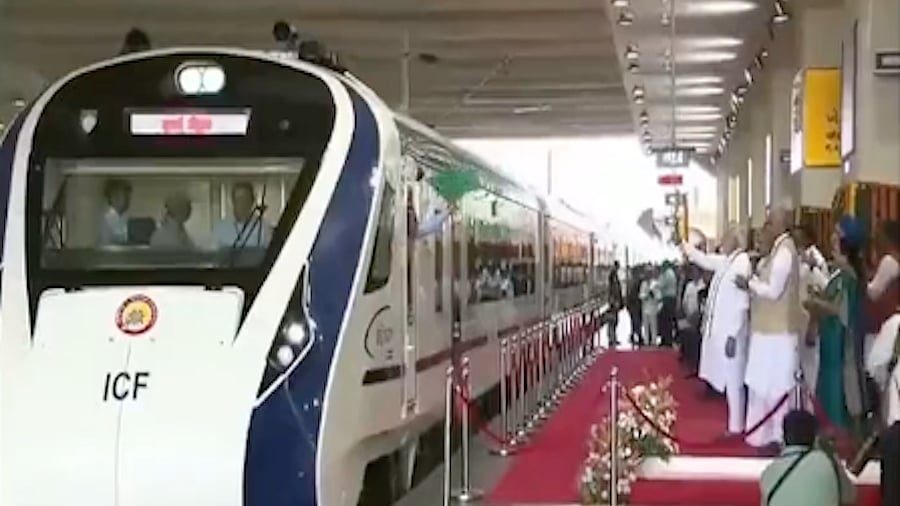India
Vande Bharat Express and the world’s fastest five trains
The first Rajdhani Express was flagged off in 1969 and Shatabdi in 1988. Rajdhanis have a permissible maximum speed of 100 kmph and Shatabdis 155. Permissible speed of Vande Bharat trains is 160 kmph

Two semi- high-speed Vande Bharat trains, their speed restricted to 160 kmph pending track upgradation, were flagged off in quick succession by Prime Minister Narendra Modi in the last fortnight beginning September 30.
While PM Modi flagged off the first Vande Bharat Express between New Delhi- Varanasi in 2019 February, he flagged off the third and the fourth Vande Bharat trains, first between Ahmedabad-Mumbai and the second between Una in Himachal Pradesh and New Delhi since September 30, 2022. The second Vande Bharat Express between New Delhi and Katra was flagged off by Home Minister Amit Shah in October, 2019.
Three of the four Vande Bharat Express trains have been flagged off by the Prime Minister ahead of crucial elections. The first one to Varanasi was flagged off months before the 2019 general election. The third and the fourth have now been flagged off by the PM ahead of Gujarat and Himachal Pradesh assembly elections this year.
How many more Vande Bharat Express trains will be ‘inaugurated’ by the PM is anybody’s guess. But observers have been quick to point out that India’s first Rajdhani Express was flagged off in 1969 and had a maximum speed of 100 kmph. The first Shatabdi Express was flagged off in 1988 and currently there are 44 Shatabdi trains running across the country. Their maximum permissible speed is 155 kmph. However, most of these trains run at speeds far below the permissible maximum speed because of unsafe terrain or tracks.
Published: undefined
While the Vande Bharat Express trains are being touted as India’s first fully indigenously built train with better aerodynamics and interiors, the facts surrounding the train do not seem to match the hype created around it.
www.railway-technology.com lists the following trains as the five fastest trains in the world. Remarkably, most of them appear to have been commissioned between 2004 and 2012 and have operational speed ranging between 320 kmph and 430 kmph. The fastest train in China connects the Shanghai Pudong international airport to the Longyang Road metro station in the city, a distance of 31 kms.
Published: undefined
Shanghai Maglev tops the list with a maximum operational speed of 430 km/h and average speed of 251kmph. The Maglev started commercial operations in April 2004. It runs on the 30.5km Shanghai Maglev Line, which is the first commercially operated high-speed magnetic levitation line, extending from Longyang Road Station of Metro Line 2 and ending at Shanghai Pudong International Airport.
Harmony CRH 380A, with maximum operational speed of 380 kmph, is currently the second fastest operating train in the world.The electric multiple unit (EMU) set a record by speeding at 486.1kmph during its trial operation on the Shanghai-Hangzhou intercity high-speed railway in December 2010 operates from Beijing to Shanghai.
AGV Italo entered into service in April 2012. It has a maximum operational speed of 360 kmph and runs on the Napoli – Roma – Firenze – Bologna – Milano corridor.
Talgo 350 in Spain achieved a speed of about 400 kmph during test runs. The train possesses an operational speed of 350 kmph operates on the Barcelona-Madrid line. It was delivered in July 2005 and began operations in June 2007
E5 Series Shinkansen Hayabusa trains, which entered service in March 2011, with an initial maximum speed of 300km now run on the Tohoku Shinkansen Line with a maximum operating speed of 320 kmph. Currently the fastest in Japan, the train achieved a speed of about 400 kmph during trials.
Published: undefined
Follow us on: Facebook, Twitter, Google News, Instagram
Join our official telegram channel (@nationalherald) and stay updated with the latest headlines
Published: undefined